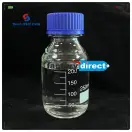-
Categories
-
Pharmaceutical Intermediates
-
Active Pharmaceutical Ingredients
-
Food Additives
- Industrial Coatings
- Agrochemicals
- Dyes and Pigments
- Surfactant
- Flavors and Fragrances
- Chemical Reagents
- Catalyst and Auxiliary
- Natural Products
- Inorganic Chemistry
-
Organic Chemistry
-
Biochemical Engineering
- Analytical Chemistry
-
Cosmetic Ingredient
- Water Treatment Chemical
-
Pharmaceutical Intermediates
Promotion
ECHEMI Mall
Wholesale
Weekly Price
Exhibition
News
-
Trade Service
A few days ago, it was learned from the First International Conference on Nanotechnology and Sustainable Agricultural Technology Development that the multifunctional nanomaterials and agricultural application innovation team from the Institute of Agricultural Environment and Sustainable Development of the Chinese Academy of Agricultural Sciences used nanotechnology to successfully develop a Batches of high-efficiency and safe new pesticide formulations, including pesticides, fungicides and herbicides
.
Studies have shown that if this type of nano-pesticide is fully promoted and applied, it can reduce the amount of pesticides in China by more than 30%, reduce the use of benzene organic solvents in pesticide formulations by 500,000 tons per year, and greatly reduce pesticide residue pollution
.
The research team used nanotechnology to reduce the existing pesticide particles from 5 microns to 100 nanometers on the one hand, increase the adhesion and coverage of the pesticide particles to the surface of crop leaves and harmful organisms, and enhance the pesticide particles in the liquid.
For dispersibility and dissolution efficiency, water directly replaces benzene-containing organic solvents to prevent solvent pollution; on the other hand, nanomaterials are used to load pesticide particles to achieve slow release of drugs, extend the duration of validity, and reduce the number of pesticide applications
.
At present, the batch of nano-pesticides has been used for industrialized development, promotion and application
.
.
Studies have shown that if this type of nano-pesticide is fully promoted and applied, it can reduce the amount of pesticides in China by more than 30%, reduce the use of benzene organic solvents in pesticide formulations by 500,000 tons per year, and greatly reduce pesticide residue pollution
.
The research team used nanotechnology to reduce the existing pesticide particles from 5 microns to 100 nanometers on the one hand, increase the adhesion and coverage of the pesticide particles to the surface of crop leaves and harmful organisms, and enhance the pesticide particles in the liquid.
For dispersibility and dissolution efficiency, water directly replaces benzene-containing organic solvents to prevent solvent pollution; on the other hand, nanomaterials are used to load pesticide particles to achieve slow release of drugs, extend the duration of validity, and reduce the number of pesticide applications
.
At present, the batch of nano-pesticides has been used for industrialized development, promotion and application
.







